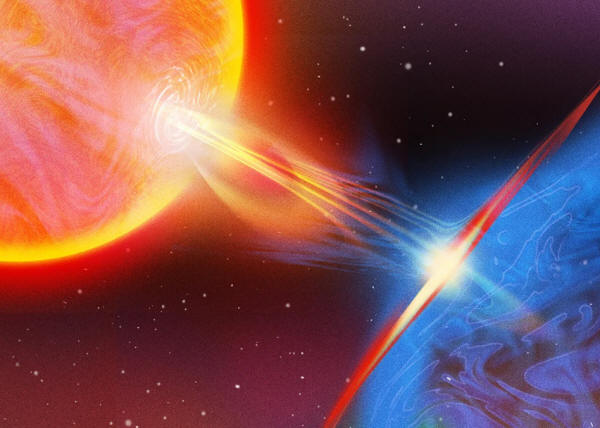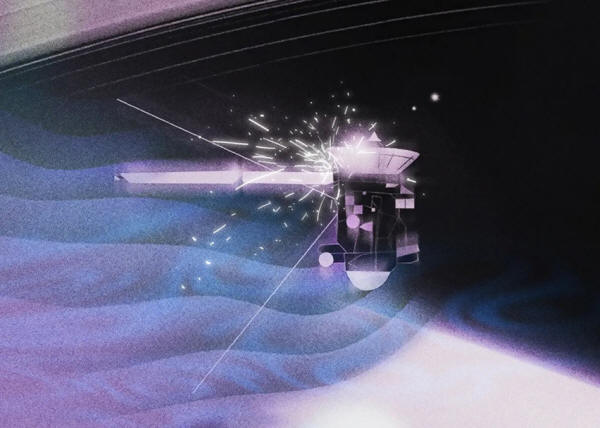|
by Matt Ribel Jun 21, 2022 from Wired Website
An illustration of a solar storm in space
our star fires off a plasma bomb in a random direction.
Our best hope the next time Earth is in the crosshairs?
Capacitors.
It's 27 million degrees inside and packed with excited bodies - helium atoms fusing, nuclei colliding, positrons sneaking off with neutrinos. When the photon heads for the exit, the journey there will take, on average, 100,000 years. (There's no quick way to jostle past 10 septillion dancers, even if you do move at the speed of light.)
Once at the
surface, the photon might set off solo into the night. Or, if it
emerges in the wrong place at the wrong time, it might find itself
stuck inside a coronal mass ejection, a mob of charged particles
with the power to
upend civilizations.
Generated by the churning of particles in the core, it originates as a series of orderly north-to-south lines. But different latitudes on the molten star rotate at different rates - 36 days at the poles, and only 25 days at the equator. Very quickly, those lines stretch and tangle, forming magnetic knots that can puncture the surface and trap matter beneath them.
From afar, the resulting patches appear dark.
They're
known as sunspots. Typically, the trapped matter cools, condenses
into plasma clouds, and falls back to the surface in a fiery coronal
rain. Sometimes, though, the knots untangle spontaneously,
violently. The sunspot turns into the muzzle of a gun: Photons flare
in every direction, and a slug of magnetized plasma fires outward
like a bullet.
At 11:18 am on September 1, 1859, Richard Carrington, a 33-year-old brewery owner and amateur astronomer, was in his private observatory, sketching sunspots - an important but mundane act of record-keeping. That moment, the spots erupted into a blinding beam of light.
Carrington sprinted off in search of a witness. When he returned, a minute later, the image had already gone back to normal. Carrington spent that afternoon trying to make sense of the aberration.
While he stewed, a plasma bomb silently barreled toward Earth
at several million miles per hour.
That's what happened on September 2, the day after
Carrington saw the blinding beam.
ILLUSTRATION: MARK PERNICE
A typical bolt of lightning registers 30,000 amperes. This geomagnetic storm registered in the millions. As the clock struck midnight in New York City, the sky turned scarlet, shot through with plumes of yellow and orange. Fearful crowds gathered in the streets.
Over the continental divide, a bright-white midnight aurora roused a group of Rocky Mountain laborers; they assumed morning had arrived and began to cook breakfast. In Washington, DC, sparks leaped from a telegraph operator's forehead to his switchboard as his equipment suddenly magnetized.
Vast sections of
the nascent telegraph system overheated and shut down.
In May 1921, train-control
arrays in the American Northeast and telephone stations in Sweden
caught fire. In 1989, a moderate storm, just one-tenth the strength
of the 1921 event, left Quebec in the dark for nine hours after
overloading the regional grid. In each of these cases, the damage
was directly proportional to humanity's reliance on advanced
technology - more grounded electronics, more risk.
But we won't understand the true threat level until the cloud reaches the Deep Space Climate Observatory, a satellite about a million miles from Earth. It has instruments that analyze the speed and polarity of incoming solar particles.
If a cloud's magnetic
orientation is dangerous, this $340 million piece of equipment will
buy humanity - with its 7.2 billion cell phones, 1.5 billion
automobiles, and 28,000 commercial aircraft - at most one hour of
warning before impact.
ILLUSTRATION: MARK PERNICE
At the beginning of each cycle, clusters of sunspots form at the middle latitudes of both solar hemispheres. These clusters grow and migrate toward the equator. Around the time they're most active, known as solar maximum, the sun's magnetic field flips polarity.
The sunspots wane, and solar minimum comes.
Then it happens all over again.
Today, in the 25th solar cycle since regular record - keeping began, scientists don't have much to show beyond that migration pattern.
They don't fully understand why the poles flip. They cannot explain why some sunspot cycles are as short as nine years while others last 14. They cannot reliably predict how many sunspots will form or where coronal mass ejections will occur.
What is clear is that a big one can happen in any kind of cycle:
Still, a more active cycle increases the
chances of that near miss becoming a direct hit.
the 10,000 or so commercial planes in the sky will attempt a simultaneous grounding.
Pilots will eyeball themselves into a flight pattern while air traffic controllers use light signals to guide the planes in.
One of the more
influential models, which offers respectable predictive power, uses
the magnetic strength of the sun's polar regions as a proxy for the
vigor of the following cycle. In 2019, a dozen scientists empaneled
by NASA predicted that the current solar cycle will peak with 115
sunspots in July 2025 - well below the historical average of 179.
He believes the old-school models are concerned with the wrong thing - sunspots, rather than the processes that create them.
McIntosh's attempt to do that goes back to 2002, when, at the behest of a postdoctoral mentor, he began plotting tiny ultraviolet concentrations on the solar surface, known as brightpoints.
He found that brightpoints originate at higher latitudes than sunspots do but
follow the same path to the equator. To him, this implied that
sunspots and brightpoints are twin effects of the same underlying
phenomenon, one not found in astrophysics textbooks.
At any given time, there are usually two oppositely charged bands in each hemisphere. They counteract each other, which promotes relative calm at the surface. But magnetic bands don't all live to be the same age.
Some reach what McIntosh calls
"the terminator" with unusual
speed. When this happens, the younger bands are left alone for a few
years, without the moderating influence of the older bands, and they
have a chance to raise hell. The most recent terminator, their data suggests, happened on December 13, 2021.
In the days that followed, magnetic activity near the sun's equator dissipated (signaling the death of one set of bands) while the number of sunspots at midlatitude rapidly doubled (signaling the solo reign of the remaining bands).
Because this
terminator arrived slightly sooner than expected, McIntosh predicts
above-average activity for the current solar cycle, peaking at
around 190 sunspots.
He yearns for a set of satellites orbiting the sun - a few at the poles and a few around the equator, like the ones used to forecast terrestrial weather. The price tag for such an early-warning system would be modest, he argues: eight craft at roughly $30 million each.
But will anyone fund it?
When the next solar storm approaches Earth and the deep-space satellite provides its warning - maybe an hour in advance, or maybe 15 minutes, if the storm is fast-moving - alarms will sound on crewed spacecraft.
Astronauts will proceed to cramped modules lined with
hydrogen-rich materials like polyethylene, which will prevent their
DNA from being shredded by protons in the plasma. They may float
inside for hours or days, depending on how long the storm endures.
As the atmosphere heats up, it will swell, and satellites will drag, veer off course, and risk collision with each other and space debris.
Some will fall out of orbit entirely. Most new satellites are equipped to endure some solar radiation, but in a strong enough storm, even the fanciest circuit board can fry. When navigation and communication systems fail, the commercial airline fleet - about 10,000 planes in the sky at any given time - will attempt a simultaneous grounding.
Pilots will eyeball themselves into a flight pattern while air traffic controllers use light signals to guide the planes in.
Those living near military installations may
see government aircraft scrambling overhead; when radar systems jam,
nuclear defense protocols activate.
In regions with
resistive rock (in the US, especially the Pacific Northwest, Great
Lakes, and Eastern Seaboard), the most convenient route is upward,
through the electrical grid.
The largest transformers, numbering around 2,000 in the United States, are firmly anchored into the ground, using Earth's crust as a sink for excess voltage. But during a geomagnetic storm, that sink becomes a source.
Most transformers are only built to handle alternating current, so storm-induced direct current can cause them to overheat, melt, and even ignite. As one might expect, old transformers are at higher risk of failure.
The average American transformer is 40 years old, pushed beyond its
intended lifespan.
were to blow out in the wrong places, the US could experience
coast-to-coast outages for months.
The features of individual transformers - age, configuration, location - are typically considered trade secrets. Metatech, an engineering firm frequently contracted by the US government, offers one of the more dire estimates. It finds that a severe storm, on par with events in 1859 or 1921, could destroy 365 high-voltage transformers across the country - about one-fifth of those in operation.
States along the East Coast could see transformer failure rates ranging from 24 percent (Maine) to 97 percent (New Hampshire).
Grid failure on this scale would leave at least 130 million people in the dark. But the exact number of fried transformers may matter less than their location.
In 2014, The Wall Street Journal reported findings from an unreleased Federal Energy Regulatory Commission report on grid security:
Prolonged national grid failure is new territory for humankind.
Documents from an assortment of government agencies and private organizations paint a dismal picture of what that would look like in the United States. Homes and offices will lose heating and cooling; water pressure in showers and faucets will drop. Subway trains will stop mid-voyage; city traffic will creep along unassisted by stoplights.
Oil production will grind to a halt, and so will shipping and transportation. The blessing of modern logistics, which allows grocery stores to stock only a few days' worth of goods, will become a curse. Pantries will thin out within a few days. The biggest killer, though, will be water.
Fifteen percent of treatment facilities in the country serve 75 percent of the population - and they rely on energy-intensive pumping systems. These pumps not only distribute clean water but also remove the disease- and chemical-tainted sludge constantly oozing into sewage facilities.
Without power, these waste systems could overflow, contaminating
remaining surface water.
With death tolls
mounting and morgues losing refrigeration, municipalities will face
grave decisions about how to safely handle bodies.
Koroush Shirvan, a nuclear safety expert at MIT, warns that
many reactors could run into trouble if outages last longer than a
few weeks.
He has published 50 scientific papers, spoken before Congress and NATO, and advised half a dozen federal agencies and commissions.
The soft-spoken utility veteran is the man behind the cataclysmic Metatech projections, and he is either a visionary or an alarmist, depending on whom you ask. Kappenman spent the first two decades of his career climbing the ladder at Minnesota Power, learning the ins and outs of the utility industry.
In 1998, he
joined Metatech, where he advised governments and energy companies
on space weather and grid resilience.
that greatly magnify
their
vulnerability to these storms."
Notably, however, JASON did not challenge Kappenman's work on its merits, nor did the group offer a competing model.
Rather, its objections were rooted in the fact that Metatech's models are proprietary, and utility industry secrecy makes it hard to run national grid simulations.
Still, the authors echoed Kappenman's essential conclusion:
The good news is that a technical fix already exists.
Mitigating this threat could be as simple as outfitting vulnerable transformers with capacitors, relatively inexpensive devices that block the flow of direct current. During the 1989 storm in Quebec, the grid fell offline and stopped conducting electricity before the current could inflict widespread damage. One close call was enough, though.
In the years after, Canada spent more than $1 billion on reliability upgrades, including capacitors for its most vulnerable transformers.
A 2020
study by the Foundation for Resilient Societies arrived at a similar
figure for comprehensive grid hardening: about $500 million a year
for 10 years.
Tom Berger, former director of the US government's Space Weather Prediction Center, also expressed doubts about grid operators.
But Berger's confidence waned after the February 2021 collapse of the Texas power grid, which killed hundreds of people, left millions of homes and businesses without heat, and caused about $200 billion in damage.
That crisis was brought on by nothing more exotic than a big cold snap.
I reached out to 12 of the country's largest utility companies, requesting information on specific steps taken to mitigate damage from a major geomagnetic event.
American Electric Power, the country's largest transmission network, was the only company to share concrete measures, which it says include regularly upgrading hardware, redirecting current during a storm, and quickly replacing equipment after an event.
Two other companies, Consolidated Edison and Exelon, claim to have outfitted their systems with geomagnetic monitoring sensors and be instructing their operators in unspecified "procedures."
Florida Power & Light declined to meaningfully
comment, citing security risks. The other eight did not respond to
multiple requests for comment.
In 2005, when George W. Bush, a former oil executive, occupied the Oval Office, Congress passed the Energy Policy Act, which included a grab bag of giveaways to the oil and gas industry. It rescinded much of the Federal Energy Regulatory Commission's authority to regulate the utility industry.
Reliability standards are now developed and enforced by the North
American Electric Reliability Corporation - a trade association that
represents the interests of those same companies.
Kappenman objected to the first set of standards, proposed in 2015, on the grounds that they were too lenient - they didn't require utilities to prepare for a storm on par with 1859 or 1921.
Berger took issue too, but for a different reason:
The ground-based effects of the
Carrington Event lasted
four or five consecutive days; a transformer built to withstand 10
seconds of current is very different from one ready for 120 hours.
(Comparison with an old storm like Carrington, she noted, "is challenging because high-fidelity historical measurement data is not available.")
Though the new standards require utilities
to fix vulnerabilities in their systems, the companies themselves
determine the right approach - and the timeline.
Under normal supply and demand conditions, lead times for these structures can reach two years.
Insiders know not to buy a transformer unless the factory that made it is at least 10 years old.
In a time of solar crisis, foreign governments - even geopolitical allies - may throttle exports of vital electrical equipment, Kappenman notes.
Some spare-part programs have cropped up
over the past decade that allow participants to pool resources in
various disaster scenarios. The size and location of these spares,
however, are unknown to federal authorities - because the industry
won't tell them.
Governments may figure out a way to stand up emergency transformers in a pinch. And there the sun will be - the inconceivable, inextinguishable furnace at the center of our solar system that destroys as indiscriminately as it creates.
Life on this little mote depends entirely on the mercy of a cosmic nuclear power with an itchy trigger finger.
No human triumph will ever change that.
|





